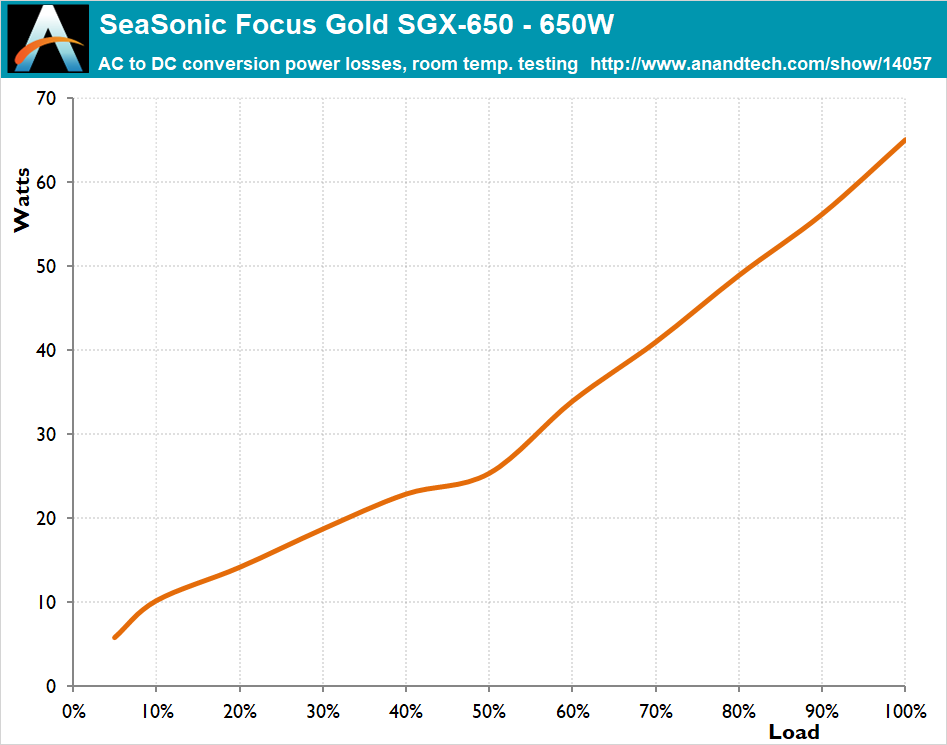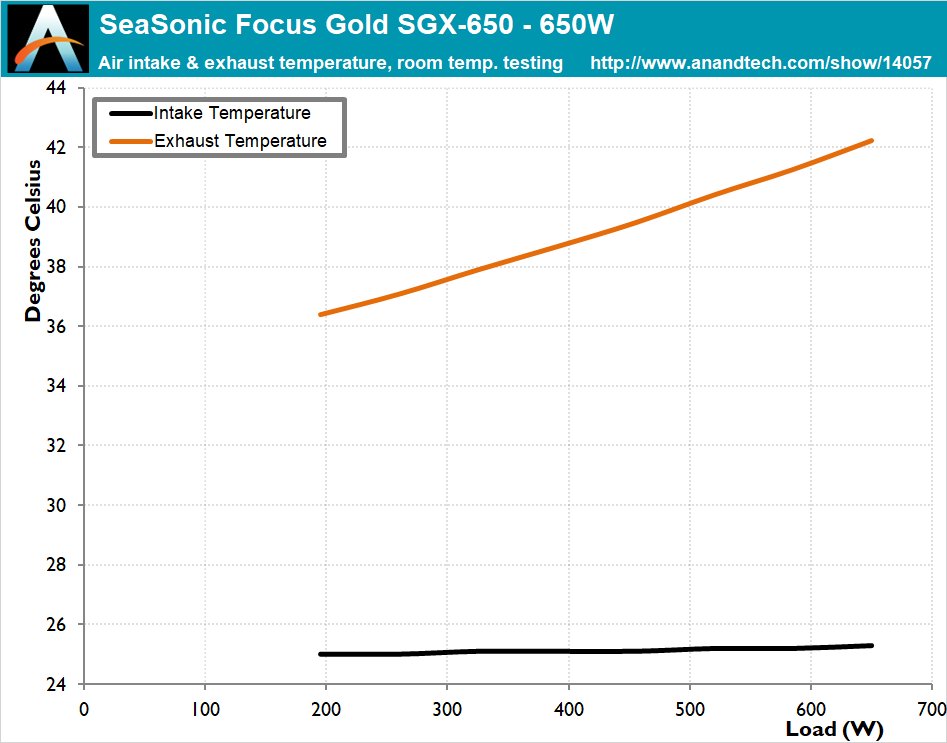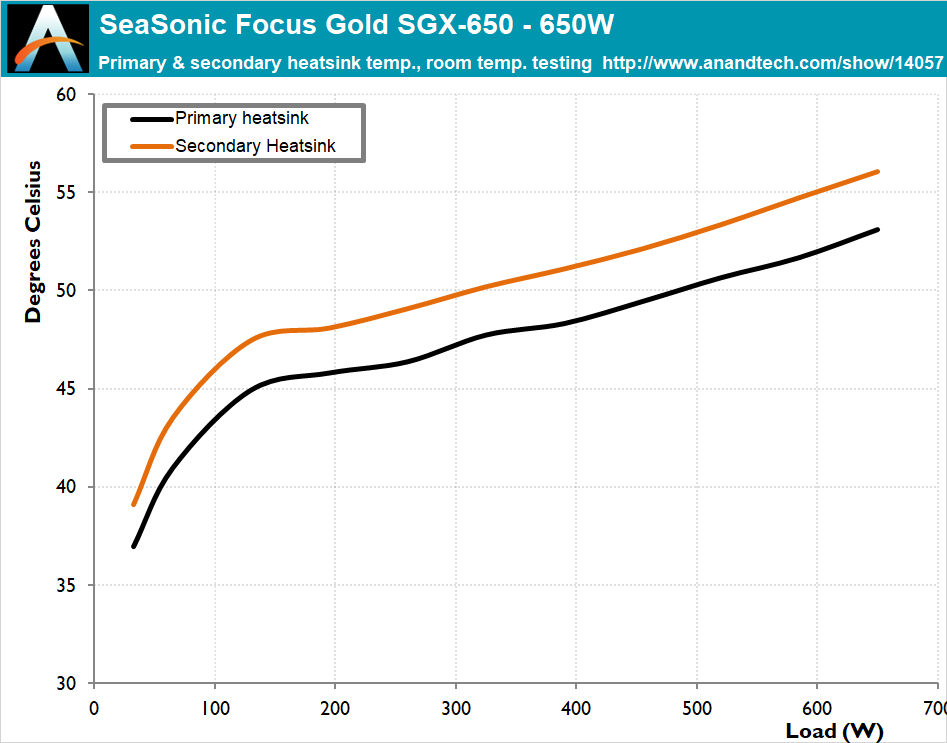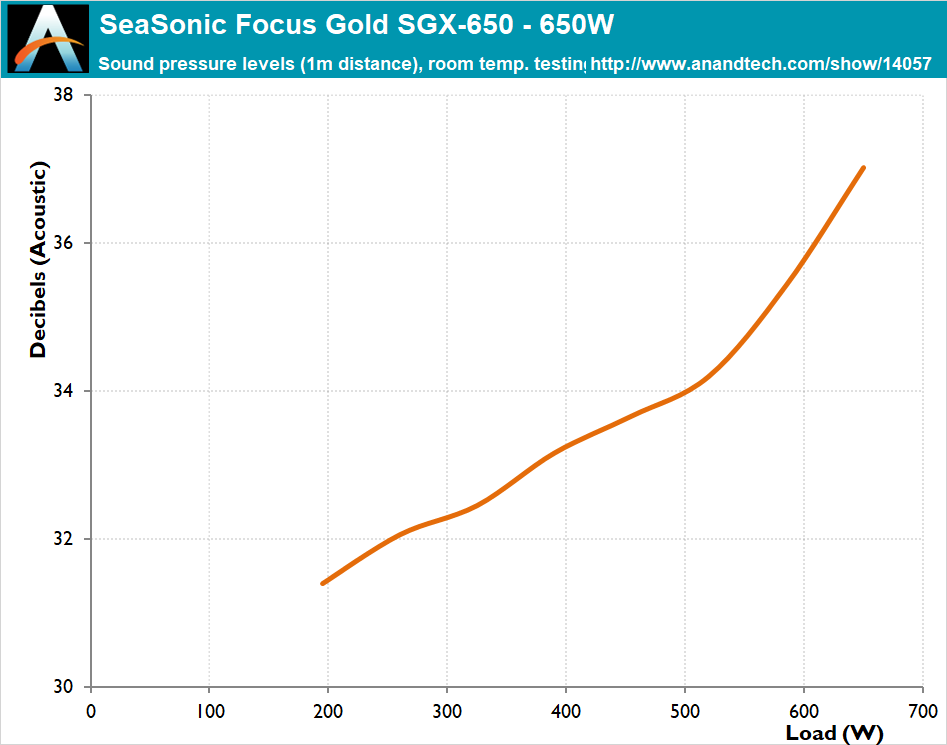The SeaSonic Focus Gold SGX-650 SFX Power Supply Review: Seasonic Starts off SFX With a Stunner
by E. Fylladitakis on March 7, 2019 8:30 AM EST- Posted in
- Cases/Cooling/PSUs
- Seasonic
- PSUs
- SFX
- Focus Gold SGX
Cold Test Results
For our PSU testing, we are using various high precision electronic loads with a maximum power draw of 2700 Watts, a Rigol DS5042M 40 MHz oscilloscope, an Extech 380803 power analyzer, two high precision UNI-T UT-325 digital thermometers, an Extech HD600 SPL meter, a self-designed hotbox and various other bits and parts. For a thorough explanation of our testing methodology and more details on our equipment, please refer to our How We Test PSUs - 2014 Pipeline post.
The efficiency of the SeaSonic Focus Gold SGX-650 SFX PSU is very good. Although the unit technically fails to meet the 80Plus Gold certification requirement for 90% efficiency at a 20% load when powered from a 230V AC source, it showcased exceptional efficiency across the entire load range. Conversely however, the efficiency drop when the unit is powered from a 115V AC source is very small, from practically zero at low loads up to a maximum of about 0.75%. This allows the unit to easily surpass the 80Plus Gold requirements for an input voltage of 115V AC.
SeaSonic designed the thermal control of the Focus Gold SGX-650 to utilize a semi-fanless mode, meaning that the fan will start only after the load is greater than about 180 Watts or when it is absolutely necessary. As expected, the internal temperatures of the PSU rise sharply under low loads due to the lack of active cooling, but they quickly stabilize once the fan starts. Considering the size and compactness of the design, the internal temperatures of the Focus Gold SGX-650 are quite low.
Despite the use of a low-profile 120 mm fan, it seems that the cooling requirements of the Focus Gold SGX-650 are low. Even when the fan does start, it barely reaches audible levels even when the PSU is heavily loaded. Assuming that it takes a rather powerful system to heavily load a 650 Watt PSU, it is very likely that any sound coming from the PSU will be masked by the noise of other components.















38 Comments
View All Comments
Mr Perfect - Thursday, March 7, 2019 - link
Aww, this got my hopes up. The case I have only really works with SFX, not SFX-L and the headline called this a SFX. But hey, at least Seasonic is addressing the SFF market now. For ages they've just ignored the enthusiast SFF segment.abrowne1993 - Thursday, March 7, 2019 - link
Yep, the included Amazon link even mentions that it's SFX-L in the description. Should really be specified more clearly here.E.Fyll - Thursday, March 7, 2019 - link
Technically speaking, there is no SFX-L standard; that's just a term made up by SilverStone in 2013 (or 2014, my memory fails me) to describe their SFX units that were longer than 100 mm. I try and only use that term for SilverStone's products as it does not really apply to any other manufacturer (unless they choose to use the term themselves). SeaSonic even specifies that the form factor of the SGX-650 is Intel SFX in the product's manual, which this unit clearly is not fully compliant with. I cannot just baptize it whatever I want myself though, I can only state the facts, as I did on the second page of the review.piroroadkill - Friday, March 8, 2019 - link
Once enough products fall into a "made-up" standard, it becomes a de-facto standard. That's just how it is.Death666Angel - Friday, March 8, 2019 - link
That seems like a weird cop-out. All price comparison websites in Germany I know of have SFX-L as a seperate tab and they are not only comprised of Silverstone PSUs. Who do you want to standardize the form factor anyway? As far as I can see, Intel standardized ATX and Via standardized ITX. Are we supposed to just call ITX motherboards not made by Via as "smaller than ATX" motherboards in one paragraph and then just call them ATX in the rest of the review? And of course you can "baptize" the PSU however you want in a review you are writing yourself, just give sufficient explanation and people will more than likely thank you for being more clear than the manufacturer. If you just repeat the manufacturers talking points, reviews are useless. Call a duck a duck and not a somewhat misshapen swan. If someone is first to market with a good idea, they get to name it. If the idea is so good that others start to copy/adopt it, the name likely becomes the standard for the industry.DanNeely - Friday, March 8, 2019 - link
The thing is that despite Seasonic using the term on their amazon marketing it doesn't quite fit Silverstone's made up SFX-L standard, which is 130x125x63.5. Seasonic made this one 125x125x63.5; which is a hair smaller. Unless bastardized SFX PSUs start to proliferate (like long ATX supplies have) it probably doesn't matter since everything will either be the actual standard and only support 100mm long supplies or support the 130mm length Silverstone's marketing is calling SFX-LE.Fyll - Friday, March 8, 2019 - link
I believe that using your own example will help you understand why SFX-L is not a real standard.For something to classify as a "standard", it first has to have at least some basic specifications published (and adopted by a significant portion of the industry, but even just published would do). When VIA proposed the Mini-ITX standard, they published a lengthy white paper indicating its precise dimensions, expected energy requirements and dissipation, reference guides, etc. On the other hand, "anything longer than 100mm" does not classify as a standard at all and that is why SFX-L has not been adopted as a real standard by the industry. If it eventually will, it will have to clarify precisely how long the product should be.
And, as I said above, that term was just SilverStone's invention. I cannot pretend to know what their intentions were as a company but the fact is that it never actually was anything more than a marketing term. Besides, you are not calling ATX PSUs that are more than 140 mm "ATX-L", are you?
lmcd - Thursday, March 14, 2019 - link
Why put SFX at all if it's not valid SFX? Why not just put ATX, as it's more compliant with ATX than SFX? There's even an ATX bracket included, so it clearly can be used where an ATX PSU is expected.And that's why SFX-L is the correct moniker here.
Mr Perfect - Saturday, March 9, 2019 - link
That's interesting, today I learned that SFX-L isn't a defined standard.Samus - Monday, March 11, 2019 - link
The irony is the silverstone sfx unit you are mentioning is a 550w standard length SFX PSU, though not modular. Ironic, because this Seasonic - as good as it is, really can’t handle beyond 550w at high temps where the silverstone can.The silverstone is $40 less.